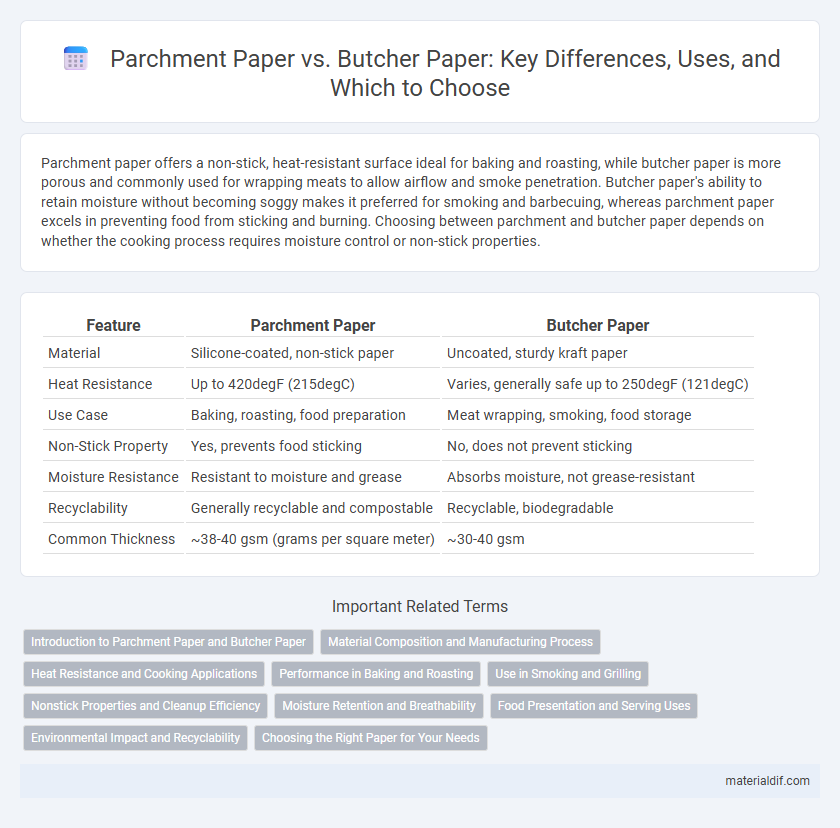Parchment paper offers a non-stick, heat-resistant surface ideal for baking and roasting, while butcher paper is more porous and commonly used for wrapping meats to allow airflow and smoke penetration. Butcher paper's ability to retain moisture without becoming soggy makes it preferred for smoking and barbecuing, whereas parchment paper excels in preventing food from sticking and burning. Choosing between parchment and butcher paper depends on whether the cooking process requires moisture control or non-stick properties.
Table of Comparison
| Feature | Parchment Paper | Butcher Paper |
|---|---|---|
| Material | Silicone-coated, non-stick paper | Uncoated, sturdy kraft paper |
| Heat Resistance | Up to 420degF (215degC) | Varies, generally safe up to 250degF (121degC) |
| Use Case | Baking, roasting, food preparation | Meat wrapping, smoking, food storage |
| Non-Stick Property | Yes, prevents food sticking | No, does not prevent sticking |
| Moisture Resistance | Resistant to moisture and grease | Absorbs moisture, not grease-resistant |
| Recyclability | Generally recyclable and compostable | Recyclable, biodegradable |
| Common Thickness | ~38-40 gsm (grams per square meter) | ~30-40 gsm |
Introduction to Parchment Paper and Butcher Paper
Parchment paper is a cellulose-based, non-stick baking sheet liner commonly used for heat-resistant cooking and baking applications, offering moisture and grease resistance. Butcher paper, made from kraft pulp, provides a durable, semi-permeable wrapping material ideal for preserving freshness and allowing meat to breathe during storage or smoking. Both papers serve unique purposes in food preparation, with parchment paper excelling in oven use and butcher paper preferred for packaging and slow cooking.
Material Composition and Manufacturing Process
Parchment paper is made by chemically treating cellulose fibers with sulfuric acid or zinc chloride, resulting in a non-stick, heat-resistant surface ideal for baking. Butcher paper is crafted from virgin wood pulp without chemical treatments, producing a porous, durable material suited for wrapping meats. The distinct manufacturing processes lead to parchment paper's grease resistance and heat durability compared to butcher paper's breathability and strength.
Heat Resistance and Cooking Applications
Parchment paper offers excellent heat resistance up to 420degF (215degC), making it ideal for baking and roasting without sticking or burning. Butcher paper withstands higher temperatures, often exceeding 500degF (260degC), and is preferred for smoking and slow-cooking meats due to its breathability and moisture retention. Choosing parchment paper suits baking delicate items, while butcher paper excels in barbecue and grilling scenarios requiring extended heat exposure.
Performance in Baking and Roasting
Parchment paper offers superior non-stick properties and heat resistance up to 420degF, making it ideal for baking delicate pastries and roasting vegetables without sticking or burning. Butcher paper, while durable and moisture-resistant, lacks the silicone coating, resulting in less effective non-stick performance and limited use in high-heat baking environments. For roasting meats, butcher paper allows better smoke penetration and moisture retention, enhancing flavor, whereas parchment paper is more suited for preventing sticking and promoting even cooking.
Use in Smoking and Grilling
Parchment paper is heat-resistant and non-stick, ideal for wrapping food during smoking to retain moisture without sticking, but it should not be used directly on open flames. Butcher paper, especially pink or white kraft paper, is breathable and commonly used in smoking meats like brisket to allow smoke penetration while keeping juices inside, making it a preferred choice for grilling and smoking enthusiasts. While parchment paper is best for delicate items and baking, butcher paper excels in slow cooking and smoking, providing optimal smoke flavor and bark formation.
Nonstick Properties and Cleanup Efficiency
Parchment paper offers superior nonstick properties due to its silicone coating, preventing food from adhering during baking and enabling effortless cleanup. Butcher paper lacks this coating, making it less effective at preventing sticking, often requiring additional oil or liners to avoid residue. Cleanup is more efficient with parchment paper, as it resists grease and moisture, whereas butcher paper can absorb oils and complicate post-cooking cleaning tasks.
Moisture Retention and Breathability
Parchment paper excels in moisture retention due to its non-stick, heat-resistant coating that prevents moisture loss during cooking, making it ideal for baking and steaming. Butcher paper offers superior breathability, allowing smoke and air to circulate while preserving the meat's natural juices, which is essential for smoking and slow-cooking barbecue. Choosing between parchment and butcher paper depends on the cooking method's need for either moisture containment or airflow to enhance food texture and flavor.
Food Presentation and Serving Uses
Parchment paper offers a non-stick, heat-resistant surface ideal for baking and presenting delicate foods, enhancing aesthetic appeal without absorption of oils or juices. Butcher paper, typically thicker and more porous, excels in wrapping and serving meats, allowing moisture to escape while preserving flavor and crispness. For food presentation, parchment paper provides a cleaner, more polished look, whereas butcher paper suits rustic or casual serving styles.
Environmental Impact and Recyclability
Parchment paper is typically coated with silicone, making it non-recyclable but biodegradable under specific composting conditions, whereas butcher paper is generally uncoated, allowing for easier recycling and more eco-friendly disposal. The environmental impact of parchment paper is higher due to chemical treatments and limited recyclability, while butcher paper's sustainability benefits stem from its minimal processing and greater compatibility with recycling programs. Choosing butcher paper reduces landfill waste and supports circular economy practices compared to parchment paper's limited end-of-life options.
Choosing the Right Paper for Your Needs
Parchment paper offers a non-stick, heat-resistant surface ideal for baking and roasting, preventing food from sticking and simplifying cleanup. Butcher paper, typically uncoated and more porous, excels in wrapping and preserving raw or smoked meats, allowing moisture to escape to maintain texture. Selecting the right paper depends on whether you need moisture resistance and non-stick properties for cooking or breathable wrapping for meat storage.
Parchment paper vs Butcher paper Infographic

 materialdif.com
materialdif.com